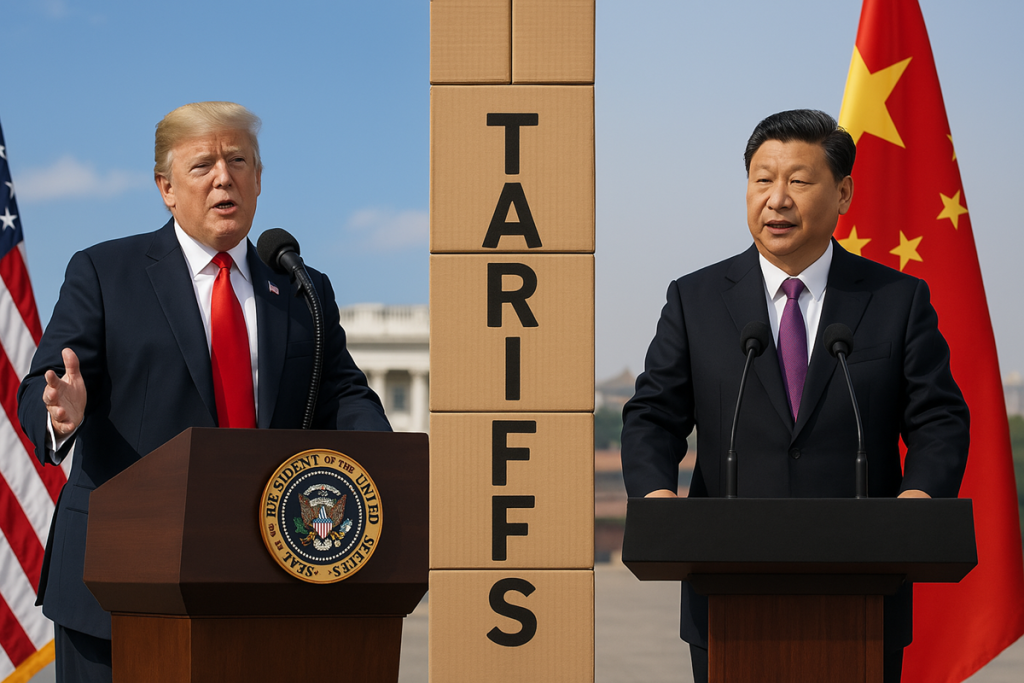The U.S. has imposed a 104% tariff on all Chinese imports, escalating a global trade conflict and sending shockwaves through supply chains. With retaliatory moves, market volatility, and political uncertainty rising, supply chain, logistics, and procurement leaders must act fast to mitigate impact.
U.S.–China Trade Tensions Explode with 104% Tariff Hike
In a stunning escalation of the trade standoff between the U.S. and China, the Trump administration has announced a 104% tariff on all imports from China, effective after midnight on April 9. This follows weeks of rapid policy shifts and retaliatory threats, marking the most aggressive trade measure of Trump’s second term to date.
The White House originally proposed a 34% tariff on Chinese goods, triggering an identical countermeasure from Beijing. But the standoff quickly intensified. President Trump increased the rate to 84%, before finally landing on the 104% figure—citing what his administration called China’s “unwillingness to engage in fair trade negotiations.”
White House Press Secretary Karoline Leavitt confirmed there would be no delays or exemptions, describing the policy as part of Trump’s plan to “rebuild American manufacturing and eliminate dependency on foreign adversaries.”
Beijing’s response has been equally firm. In addition to its own tariffs, China has imposed export controls on key raw materials and launched investigations into U.S. firms operating within its borders. “What we are seeing is a game of who can bear more pain,” said Mary Lovely, a U.S.-China trade expert, warning that both sides appear prepared for a prolonged conflict.
Global Markets Rattle as Supply Chains Feel the Shock
Markets reacted swiftly. Major European indices opened sharply lower, with the FTSE 100 falling 2.2%, Germany’s DAX down 2.3%, and France’s CAC 40 shedding 2.4%. In Asia, Taiwan’s stock exchange plummeted 5.8%, while Japan’s Nikkei closed down nearly 4%. Oil prices fell to a four-year low as fears of a global slowdown took hold.
Yet in a surprising turn, China’s domestic markets rallied after government intervention—offering a signal that Beijing is preparing to absorb the initial shock and hold its line.
Meanwhile, Trump’s broader tariff wave now extends beyond China, affecting 57 countries and territories, including 20% tariffs on EU goods, 26% on India, and nearly 50% on Cambodia. These measures are based on a disputed formula tying tariff rates to bilateral trade deficits. U.S. officials maintain the aim is to pressure trading partners into bilateral deals.
In the background, several governments—including Italy, South Korea, and the UK—have initiated diplomatic outreach or announced emergency support for affected sectors. Trump, for his part, has made clear the tariffs may be permanent, unless what he describes as “serious proposals” are brought to the table.
What Supply Chain, Procurement, and Logistics Leaders Should Do Now
This moment marks a critical inflection point for global operations teams. The 104% tariff on Chinese goods is not only a financial shock—it’s a structural disruptor with ripple effects across production, sourcing, and freight networks.
Leaders should immediately reassess exposure to Chinese imports, including Tier 2 and Tier 3 suppliers. It’s not enough to focus on primary components—many hidden dependencies exist in electronics, packaging, and raw materials that may now become cost-prohibitive or delayed.
Next, prioritize sourcing diversification and contingency modeling. For many, this means accelerating plans already in motion: shifting final assembly to Southeast Asia or Mexico, qualifying alternate suppliers in India or Eastern Europe, and exploring regional inventory buffers to guard against volatility.
Contract terms and incoterms should also be revisited. Where tariffs trigger significant landed cost increases, renegotiating who bears the burden—and how long pricing is locked—will be critical for managing P&L exposure in volatile categories.
Technology will play a vital role. Firms with real-time visibility platforms, tariff scenario modeling tools, and supplier risk maps will be far better equipped to respond with precision. For others, the urgency to digitize sourcing and logistics functions just became business-critical.
A Hard Reset for Global Trade Strategy
While political headlines dominate, the deeper story is clear: global trade assumptions are being rewritten in real time. The 104% tariff isn’t a policy tweak—it’s a signal that resilience and agility must now be core design principles in every supply chain.
In the near term, expect price inflation across electronics, industrial components, and consumer goods. In the medium term, anticipate greater regionalization, accelerated decoupling from Chinese supply chains, and a new wave of cost- and compliance-driven reshoring.
As the U.S. moves toward a deal-based bilateral trade regime and China digs in, Europe’s position will become increasingly pivotal—caught between economic ties to both superpowers. For EU-based supply chain leaders, this is a moment to not only react—but to reposition.



